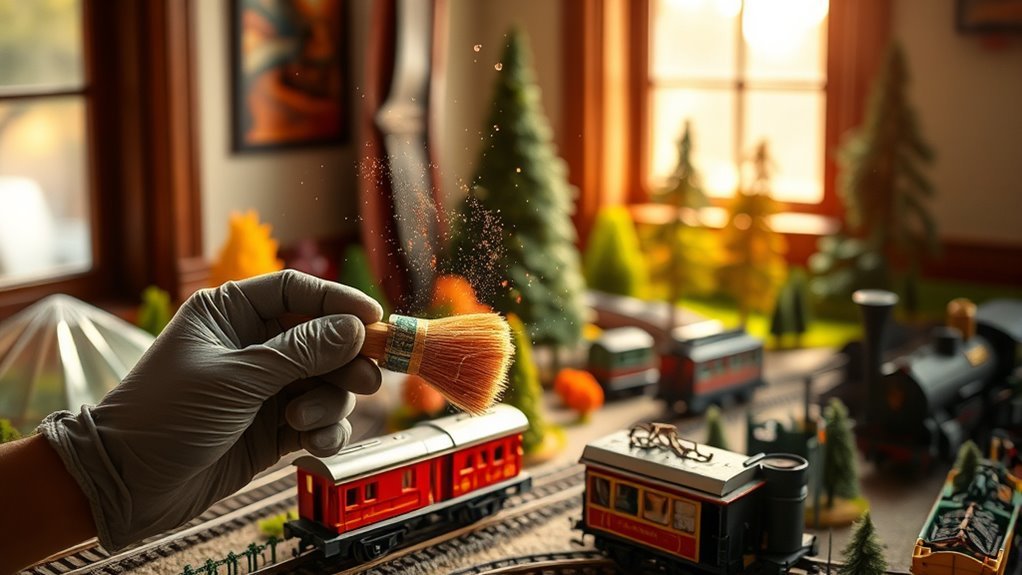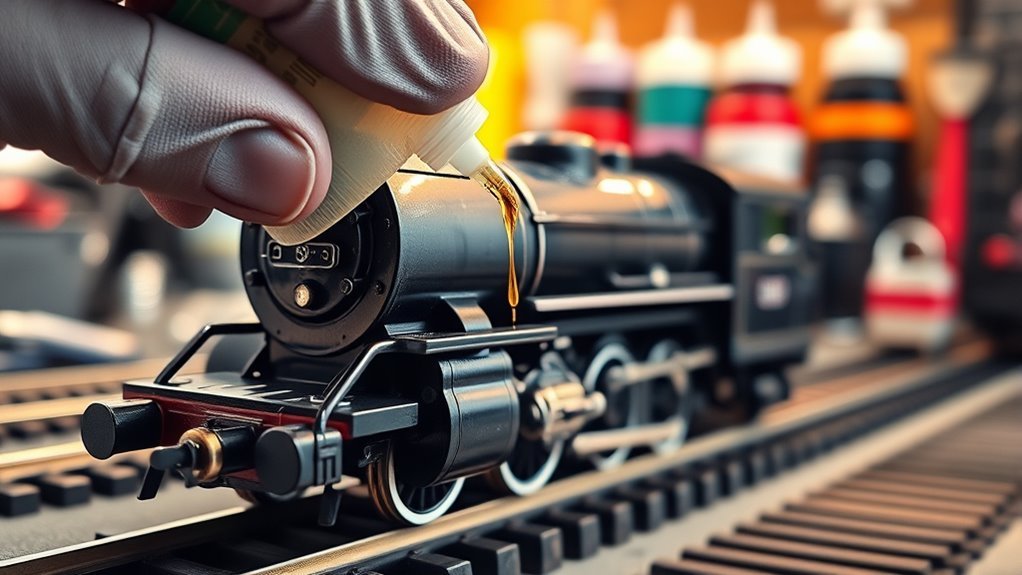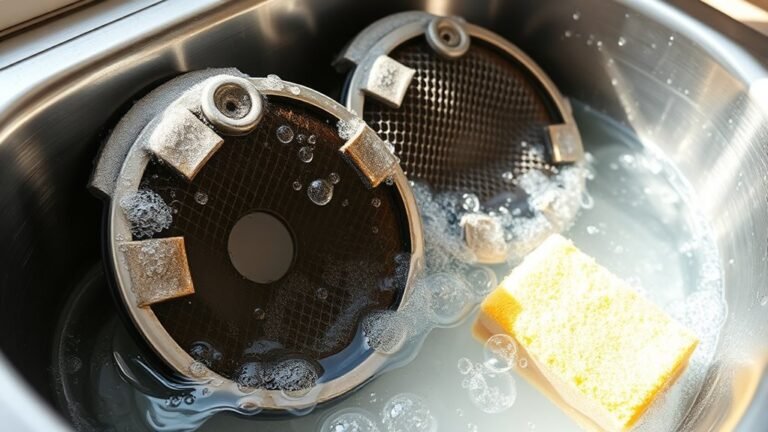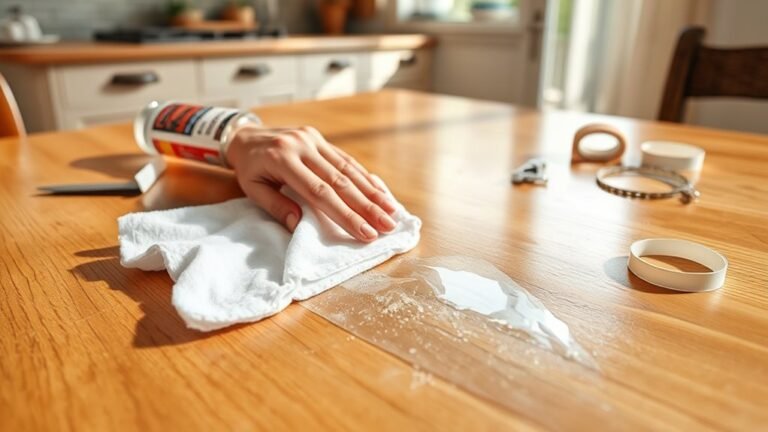How to Keep a Model Train Setup Clean and Operational
To keep your model train setup clean and running smoothly, use quality microfiber cloths, soft brushes, and specialized cleaners for tracks and trains. Clean your tracks with isopropyl alcohol to maintain good electrical contact, and gently remove dust with brushes or compressed air. Lubricate moving parts sparingly with proper oils, and regularly check electrical connections for corrosion or loose wires. Store trains safely in padded boxes. If you want to guarantee long-lasting performance, learn how to troubleshoot and maintain your layout routinely.
Tools Needed for Cleaning and Maintenance

Keeping your model train setup spotless requires the right tools. You’ll want cleaning supplies that are gentle yet effective—like microfiber cloths, soft brushes, and specialized track cleaners—to keep every detail crisp without damage. Maintenance tools such as precision screwdrivers, tweezers, and small lubricants help you access tight spots and keep moving parts smooth. Having these essentials on hand gives you the freedom to maintain your layout whenever you choose, without hassle. Investing in quality tools means less downtime and more time enjoying your trains running flawlessly. With the proper cleaning supplies and maintenance tools, you’ll stay in control of your setup’s condition, ensuring it remains both visually appealing and operational for every adventure you plan.
Cleaning Model Train Tracks Effectively
Once you have the right tools ready, cleaning your model train tracks becomes a straightforward task. Start by running a track cleaning car or using a soft cloth with isopropyl alcohol to remove dirt and oxidation. Avoid abrasive materials that can damage rails. Regular track cleaning guarantees smooth electrical contact, preventing your trains from stalling or slowing down. Incorporate maintenance techniques like inspecting track joints and tightening loose connections to keep everything reliable. You might also try specialized track cleaning solutions for stubborn grime, but always test on a small section first. By keeping your tracks clean and well-maintained, you free yourself from constant troubleshooting, allowing your trains to run smoothly and your setup to stay enjoyable without hassle.
Removing Dust From Trains and Scenery

Keeping your trains and scenery dust-free takes a gentle touch to avoid damage. You’ll want to use soft brushes or compressed air to reach tight spots without disturbing delicate details. Let’s explore the best ways to clean those intricate parts without causing harm.
Gentle Dusting Techniques
A few simple tools can make gentle dusting of your model trains and scenery much easier and safer. To maintain freedom in your hobby without damage, you’ll want to master gentle brush techniques and proper microfiber cloth usage. Here’s how to start:
- Use a soft, fine-bristle brush to sweep away dust from delicate parts without scratching.
- Lightly wipe flat surfaces with a clean microfiber cloth to trap dust without pushing it deeper.
- Always move in one direction to avoid redistributing particles.
- Avoid excessive pressure; let the tools do the work to preserve paint and details.
Using Compressed Air
Although gentle brushing works well for most dust, compressed air can reach tight spots and intricate details that brushes might miss. Using compressed air benefits your model train setup by quickly blowing away dust from hard-to-reach areas without damaging delicate parts. You’ll find it especially useful for cleaning engine grills, undercarriages, and tiny crevices. However, safety precautions are essential. Always use short bursts to avoid moisture buildup and hold the can upright to prevent propellant from spraying on your models. Wear eye protection and work in a well-ventilated space to avoid inhaling any particles. By following these steps, you’ll maintain your trains’ freedom to operate smoothly and keep your layout looking sharp without risking harm to your cherished collection.
Cleaning Scenic Details
When dust settles on your trains and scenery, it can dull their appearance and affect performance. Keeping scenic materials clean lets you enjoy the freedom of a vibrant, realistic setup. Here’s how to remove dust without damaging delicate details:
- Use a soft brush to gently sweep dust off trees, grass, and buildings.
- Employ compressed air at a low setting for hard-to-reach spots.
- Lightly dab a microfiber cloth on smooth surfaces to avoid dislodging weathering techniques.
- For stubborn grime, use a cotton swab moistened with distilled water, testing first on a small area.
Lubricating Moving Parts on Locomotives

To keep your locomotives running smoothly, you’ll need to choose the right lubricants designed for model trains. Applying them carefully to moving parts prevents wear without attracting dust or grime. Let’s go over the best types of lubricants and how to apply them properly.
Choosing Proper Lubricants
Since your model train’s performance depends heavily on smooth operation, choosing the right lubricants is essential for keeping moving parts on locomotives running quietly and efficiently. Selecting lubricants means understanding lubricant types and their specific uses. Here’s what you need to know:
- Use light oils for gears and motor bearings to reduce friction without gumming up.
- Grease works best for axles and wheel bearings, providing lasting protection.
- Avoid household oils—they can attract dust and damage delicate parts.
- Opt for specialty model train lubricants designed for plastic and metal components.
Applying Lubricant Techniques
Apply lubricants sparingly and precisely to avoid excess buildup that can attract dirt and impair your model train’s performance. When choosing lubrication types, opt for lightweight oils or synthetic greases designed specifically for miniature moving parts. Avoid heavy or general-purpose lubricants that can gum up your locomotive. For application methods, use a fine applicator or a small brush to target gears, axles, and motor bearings directly. This precision guarantees the right amount reaches each part without overspreading. Remember, less is more—over-lubrication leads to grime accumulation, restricting movement. Regularly check and reapply lubricant only when necessary to keep your train running smoothly. By mastering these techniques, you maintain freedom from mechanical issues and enjoy your model railway’s full potential without unnecessary maintenance hassles.
Checking and Maintaining Electrical Connections
Anyone who owns a model train setup knows that reliable electrical connections are essential for smooth operation. To keep your trains running freely, regular electrical inspection and connection cleaning are musts. Here’s how you can maintain your setup:
- Turn off power and visually inspect all wiring and connectors for damage or corrosion.
- Use a contact cleaner or isopropyl alcohol with a soft brush to clean dirty connections.
- Tighten any loose terminals or solder joints to guarantee solid contact.
- Test each section with a multimeter to confirm consistent voltage flow.
Preventing and Fixing Track Oxidation
You’ll want to watch out for oxidation, which happens when moisture and dirt build up on your tracks, causing poor electrical contact. Regularly cleaning your rails with a proper cleaner or fine abrasive can keep things running smoothly. Plus, simple preventative steps like covering your layout when not in use can help stop oxidation before it starts.
Causes of Track Oxidation
Track oxidation happens when moisture and air cause the metal rails to corrode, leading to poor electrical conductivity and unreliable train operation. Understanding track corrosion causes can help you keep your setup running smoothly and freely. Moisture accumulation factors play a big role in accelerating oxidation. Here are the main culprits:
- High humidity – Damp environments speed up rust formation on your tracks.
- Poor ventilation – Lack of airflow traps moisture, creating a perfect corrosion hotspot.
- Dust and grime buildup – These can hold moisture against the rails, worsening oxidation.
- Spills or leaks – Water from accidental spills or nearby plumbing can seep onto the track.
Cleaning Techniques for Tracks
Three essential cleaning techniques can help prevent and fix track oxidation, keeping your model train running smoothly. First, use a soft eraser or track cleaning block to gently remove oxidation buildup without damaging rails. Next, apply isopropyl alcohol with a lint-free cloth for deeper cleaning, which dissolves stubborn grime. Finally, polish the rails with a fine abrasive pad sparingly to restore conductivity. These track cleaning methods are straightforward, giving you freedom to maintain your layout effortlessly.
| Technique | Tool Used | Benefit |
|---|---|---|
| Eraser Cleaning | Soft Eraser | Removes oxidation safely |
| Alcohol Cleaning | Isopropyl Alcohol | Dissolves grime |
| Polishing | Fine Abrasive Pad | Restores conductivity |
Regularly using these maintenance tips guarantees peak track performance without hassle.
Preventative Maintenance Tips
Although oxidation on rails can be frustrating, consistent preventative maintenance can keep it at bay and guarantee your trains run smoothly. To enjoy hassle-free operation and maintain your setup’s freedom, create a maintenance schedule that includes regular preventative cleaning. Here’s how to stay ahead of oxidation:
- Clean tracks weekly with a soft cloth or track cleaner to remove dirt and grime.
- Use a fine abrasive eraser occasionally to gently polish oxidized spots.
- Apply a specialized track lubricant sparingly to reduce wear and corrosion.
- Inspect electrical connections monthly to ascertain consistent power flow.
Handling and Storing Model Trains Properly
Because model trains are delicate and often intricate, handling and storing them properly is key to keeping your setup in top condition. When you pick up your trains, practice safe handling by using both hands and avoiding touching the wheels or electrical contacts. This prevents damage and preserves performance. For proper storage, keep your trains in sturdy, padded boxes designed for models, protecting them from dust and accidental knocks. Store them in a cool, dry place to avoid warping or rust. Label each container clearly, so you can easily find specific pieces without unnecessary handling. By prioritizing safe handling and proper storage, you maintain your trains’ freedom to run smoothly and last longer, letting you enjoy your setup without interruption or costly repairs down the line.
Troubleshooting Common Operational Issues
When your model train isn’t running smoothly, it can be frustrating, but many common issues are easy to fix once you know what to look for. Here are some troubleshooting techniques to help you regain control and freedom over your setup:
- Check track connections – Loose or dirty joints can disrupt power flow. Clean and secure them for smooth operation.
- Inspect wheels and pickups – Dirt buildup often causes poor electrical contact; clean them gently.
- Test the power supply – Verify voltage output and replace batteries or adapters if needed.
- Look for obstructions – Small debris or misaligned track pieces can block your train’s path.
Routine Maintenance Schedule for Model Railroads
To keep your model railroad running smoothly and looking its best, you’ll want to stick to a regular maintenance schedule. Start with a routine inspection every week or two, checking tracks, wheels, and electrical connections. Use a maintenance checklist to stay organized—include cleaning rails, lubricating moving parts, and verifying that switches function properly. This disciplined approach lets you catch small issues before they turn into major headaches, giving you the freedom to enjoy your layout without constant interruptions. Don’t forget to inspect scenery elements and wiring periodically, ensuring everything stays secure and dust-free. By committing to these simple, consistent steps, you’ll extend your model railroad’s life and keep it performing at its peak, all while maintaining the joy and freedom your hobby should bring.
Tips for Enhancing Layout Longevity and Performance
If you want your model train layout to last and perform at its best, adopting a few key habits will make all the difference. You can enjoy freedom in your hobby by focusing on smart layout upgrades and scenic enhancements that boost both durability and visual appeal. Here’s what you should do:
- Regularly inspect and tighten electrical connections to prevent power issues.
- Upgrade track components with corrosion-resistant materials for smoother runs.
- Enhance scenery with quality materials that resist dust and wear, keeping your layout vibrant.
- Store tools and spare parts neatly to speed up repairs and keep your workspace clear.
Frequently Asked Questions
What Is the Best Scale for Beginners in Model Railroading?
Choosing the best scale for beginners feels like picking your first adventure—exciting and full of possibilities. If you want freedom in space, N scale advantages shine; it’s compact, letting you build expansive layouts even in small rooms. On the other hand, HO scale benefits include easier handling and more detail, perfect if you crave realism without needing a massive area. So, think about your space and style, then jump in and enjoy the ride!
How Do I Create Realistic Scenery for My Model Train Layout?
To create realistic scenery for your model train layout, start by choosing quality scenery materials like foam, plaster, and scenic turf. Experiment with landscape techniques such as layering textures and blending colors to mimic nature’s look. Don’t be afraid to let your creativity run free—add trees, rocks, and water features to bring your scene to life. Play around until it feels authentic and uniquely yours, making the landscape truly your own masterpiece.
Can I Integrate Digital Controls With Older Model Train Systems?
Diving into digital integration, you can definitely blend modern control systems with your older model train setup. You’ll find there are adapters and interfaces designed to bridge the gap between classic analog tech and contemporary digital commands. This fusion frees you from limitations, letting you enjoy precise control and expanded features without replacing your favorite vintage components. Embrace the freedom to customize and upgrade, making your layout both nostalgic and cutting-edge.
What Are the Most Popular Model Train Brands for Collectors?
If you’re diving into collecting, you’ll want to explore popular brands like Lionel Trains and Bachmann Trains for classic appeal. Hornby Models and Märklin Systems offer rich European styles, while Atlas Products and Kato Unitrack provide precise track options. Don’t overlook Athearn Rolling for detailed rolling stock, Piko Models for German quality, MTH Electric for innovation, and Rivarossi Trains for vintage charm. These brands give you the freedom to tailor your collection exactly how you want it.
How Do I Safely Transport My Model Train Setup to Shows?
Transporting your model train setup is like carrying fragile glass—handle it with care. For smooth transportation, pack each piece securely using foam or bubble wrap, ensuring nothing shifts en route. Safety precautions like labeling boxes and avoiding extreme temperatures help protect delicate parts. Keep your tools handy for quick fixes on site. With these transportation tips, you’ll enjoy freedom to showcase your setup without worry or damage during travel.






